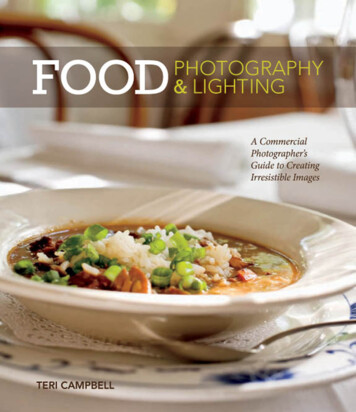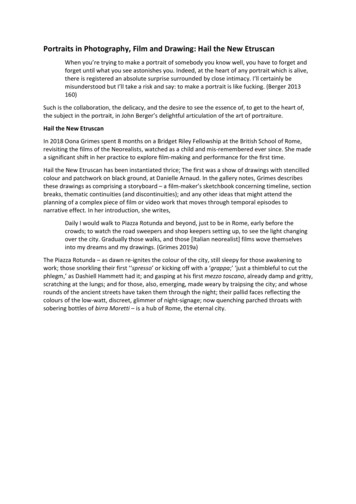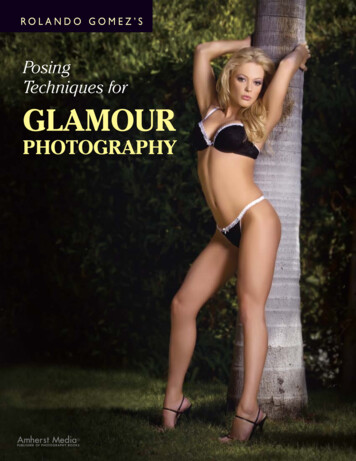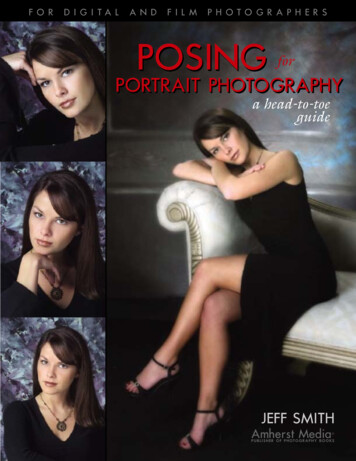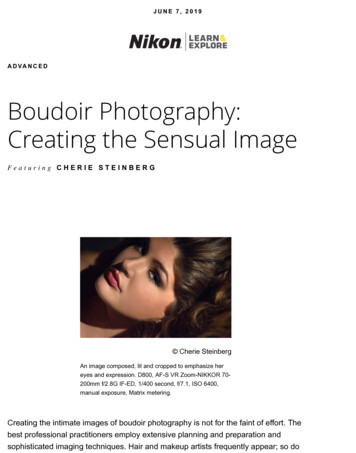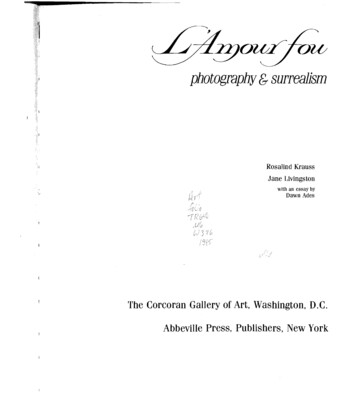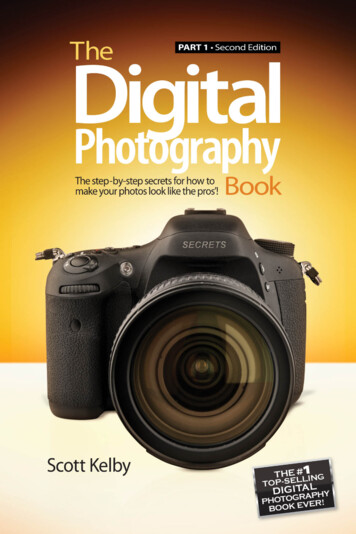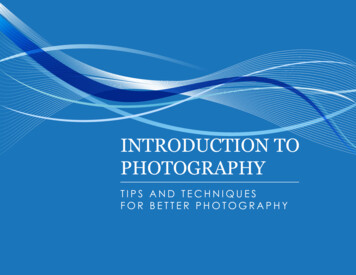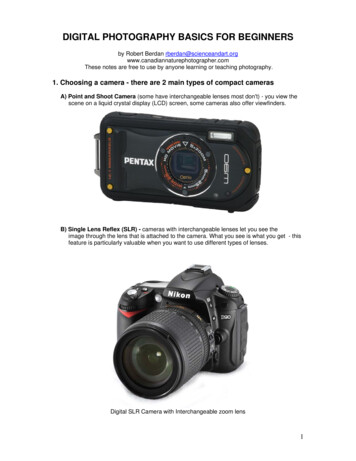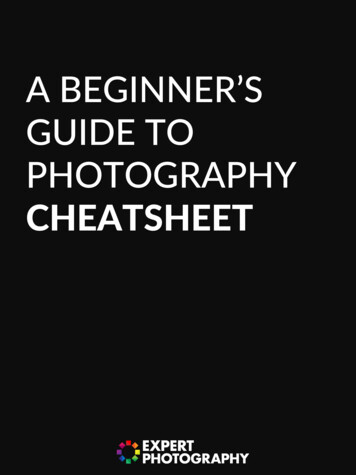
Transcription
A BEGINNER’SGUIDE TOPHOTOGRAPHYCHEATSHEET
BEGINNER PHOTOGRAPHYCHEATSHEETCameras are complicated. It took me a ton of trial and error before I startedto capture some pretty spectacular images.This cheatsheet is the reference guide I wish I had when I first started and Itruly hope it will help you in your journey to become a better photographer.EXPOSURELearning how exposure works will help you to take control of your cameraand take better photos. There are three elements that, combined, create anexposure: Aperture: the diameter of the hole inside the lens Shutter speed: filters how much light is allowed to go into the camera ISO: refers to the sensitivity of the sensor
BEGINNER PHOTOGRAPHYCHEATSHEETSTEP1APERTUREThe aperture is similar to the pupil of your eye: the wider the aperture, themore light is allowed in and vice versa.Exposure will be much easier if you can memorize the f/stop scale.As the aperture widens, the f/number gets lower and more light is allowedinto the camera. This is great for low light but be aware that it’s going tomake the depth of field very shallow – not ideal when taking landscapes. Learn more about aperture here.
BEGINNER PHOTOGRAPHYCHEATSHEETSTEP1APERTURE
BEGINNER PHOTOGRAPHYCHEATSHEETSTEP2SHUTTER SPEEDOnce the light has passed through the aperture of the lens, it reaches theshutter. Now you need to decide how much of that light you’re going toallow into the camera. A very small fraction of a second (for example 1/250) will preventmotion blue. An even smaller fraction (for example 1/4000) for sports photography A really slow shutter speed (30 seconds) is perfect for nightphotographyIt all depends on what you’re shooting and how much light you haveavailable to you.Learn more about shutter speed here.
BEGINNER PHOTOGRAPHYCHEATSHEETSTEP2SHUTTER SPEED
BEGINNER PHOTOGRAPHYCHEATSHEETSTEP3ISOOnce the light has passed through the aperture and been filtered by theshutter speed, it reaches the sensor, where we decide upon the ISO.As you turn the ISO number up, you increase the exposure but, at the sametime, the image quality decreases; there will be more digital noise or “grain”.So you have to decide upon your priorities in terms of exposure vs grain.Learn more about ISO here.
Learning how to take greatphotos is about more than justunderstanding how your cameraworks.- Josh Dunlopclicktotweet
BEGINNER PHOTOGRAPHYCHEATSHEETCOMPOSITIONIt’s important to understand exposure but, if you can’t get to grips withbasic composition, you’ll struggle to take really good photos.At the same time, you should never blindly follow the ‘rules’; use your newknowledge to shape your photos into something much more pleasing to theeye.Five compositional rules will be covered into this cheatsheet: Rule of thirds Visual weight Triangles Eye-lines Balance
BEGINNER PHOTOGRAPHYCHEATSHEETRULE1RULE OF THIRDSThis is probably the first compositional rule that any photographer comesacross and that’s for a very good reason: it’s simple and it works.The basic premise is that you divide your camera’s frame into thirds andplant key objects on these lines; the composition will work better.Photos that are correctly composed using the rule of thirds create depthand interest, adding an exciting balance between subject(s) and background.Learn more about the rule of thirds here.
BEGINNER PHOTOGRAPHYCHEATSHEETRULE2VISUAL WEIGHTVisual weight is all about what we’re drawn to when we look at a photo.When you understand visual weight, you’ll start to understand how peoplelook at photos and how you can position certain elements in a frame todirect the viewers attention to where you want them to look.Learn more about visual weight here.
BEGINNER PHOTOGRAPHYCHEATSHEETRULE3TRIANGLESTriangles are in almost everything we see in one way or another, it’s just acase of distinguishing and knowing what to do with them.Triangles make great compositional tools as they’re easy to make andmanipulate, and are remarkably common. They are also a great way ofcombining different compositional techniques, such as lines and paths, tocreate a more interesting part of a photograph.Learn more about triangles here.
BEGINNER PHOTOGRAPHYCHEATSHEETRULE4EYE-LINESIf you take photos of people, you’re taking photos with eye lines. It’simportant to understand the effect that eye lines have on how we view aphoto.Eye-lines have the ability to focus our attention on a particular part of thephoto, as well as producing tension and other photographic elements.Learn more about eye-lines here.
BEGINNER PHOTOGRAPHYCHEATSHEETRULE5BALANCEBalance in a photo affects how we feel when we look at it; it determineswhether the photo is pleasing and harmonious or uncomfortable andunresolved to look at.Learn more about balance here.
BEGINNER PHOTOGRAPHYCHEATSHEETUNDERSTANDING YOUR CAMERA1METERING MODESMetering is the process that the camera goes through when it ‘looks’ at ascene and works out what the exposure should be.The photo below was taken on spot metering mode but, if you were to takethe same photo using evaluative mode, you would end up with a completelydifferent exposure.Learn more about metering modes here.
BEGINNER PHOTOGRAPHYCHEATSHEETUNDERSTANDING YOUR CAMERA2HISTOGRAMSThe histogram shows you a mathematic review of an exposure after thephoto has been taken.It essentially tells you how evenly exposed a photo is.Learn more about histograms here.
BEGINNER PHOTOGRAPHYCHEATSHEETUNDERSTANDING YOUR CAMERA3SHOOTING MODESThere’s also a lot of misconceptions about which mode to use under whichconditions, as well as a lot of bias towards not using manual mode. Full-auto Program Aperture priority Shutter speed priority ManualWhen you understand what exactly each mode does, the one that will besuitable for your situation becomes a lot clearer.Learn more about shooting modes here.
BEGINNER PHOTOGRAPHYCHEATSHEETUNDERSTANDING YOUR CAMERA4DEPTH OF FIELDWhen you’re shooting in low light, you invariably have to widen youraperture to allow enough light into the lens but this has one rather majorside effect: shallow depth of field.There are many situations, such as landscapes, where you’ll want to beusing a narrower aperture so that the whole scene remains in focus.Learn more about depth of field here.Shallow DoF f/1.8Medium DoF f/5.6Deep DoF f/22
BEGINNER PHOTOGRAPHYCHEATSHEETUNDERSTANDING YOUR CAMERA5WHITE BALANCEThe white balance changes the color cast of the entire photo and isresponsible for the overall warmth. It can determine whether your photoappears blue or orange: from cold to warm.Learn more about white balance here.
BEGINNER PHOTOGRAPHYCHEATSHEETUNDERSTANDING YOUR CAMERA6FOCAL LENGTHThe focal length of your lens essentially determines how ‘zoomed in’ yourphotos are; the higher the number, the more zoomed your lens will be.The focal length affects more than just the ‘zoom’ – it influences theperspective too.It is often misunderstood that the focal length is measured from the front orrear of the lens when, in reality, it’s the distance between the point ofconvergence in your lens to the sensor or film in your camera.Learn more about focal length here.
BEGINNER PHOTOGRAPHYCHEATSHEETUNDERSTANDING YOUR CAMERA7CROP FACTORA lot of you may not realize but, unless you spend about 2000 on yourcamera, you’re more than likely to be shooting on a crop sensor. This meansthat your sensor is much smaller than professional SLRcameras which essentially crops the image.Learn more about crop factor here.
BEGINNER PHOTOGRAPHYCHEATSHEETUNDERSTANDING YOUR CAMERA8POLARIZING FILTERSPolarizing filters only allow light into the lens from a certain direction. Thisresults in the removal of glare and reflections from non-metallic objectssuch as water and glass, as well as haze from the sky, making for morenaturally saturated colors.Not only does this look great but it cannot be replicated in post production,hence it’s so important to understand.Learn more about polarizing filters here.
BEGINNER PHOTOGRAPHYCHEATSHEETUNDERSTANDING YOUR CAMERA9SHARP IMAGESI created a tutorial which will walk you through the 10 step process oftaking professionally sharp photos. It covers everything from choosing theright aperture and shutter speed, to shooting in RAW.It’s pretty easy to make just a few small mistakes which will result in lesssharp images, that’s why we cover all ten, in order of importance.Read my tutorial about taking sharp images here.
BEGINNER PHOTOGRAPHYCHEATSHEETUNDERSTANDING YOUR CAMERA10THE NIFTY FIFTYFor those of you who don’t know, when I talk about the nifty fifty, I’mreferring to the 50mm f/1.8 prime lens that can be picked up very cheap formost digital SLRs.It’s a great introduction to buying better quality lenses and an excellent wayof getting to grips with aperture.I recommend this lens as the first upgrade for every beginner photographerto make. It’s easy to use and, for the price, will yield some excellent results.My review & guide on the nifty fifty is here.
Want to take your photography skillsto the next level? I highly recommendyou take a look at my “PhotographyUnlocked” eBook.A BEGINNER’S GUIDETO PHOTOGRAPHYCHEATSHEET
most digital SLRs. It’s a greatintroduction to buying better quality lenses and an excellent way of getting to grips with aperture. I recommend this lens as the first upgrade for every beginner photographer to make. It’s easy to use and, for the price, will yield some excellent results. My review &

